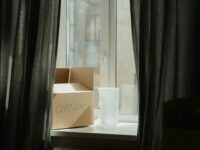The following contribution is from another author.
Moving into an old home is like stepping into a storybook filled with history, characters, and the echoes of past lives. These homes, with their unique architectural details and built-to-last craftsmanship, offer a charm that modern houses often struggle to replicate. However, the adventure of living in an old home also comes with its set of challenges. From outdated systems hidden behind beautiful facades to potential health hazards lurking in the materials of yesteryear, the journey to making an old home your own is both exciting and daunting.
As you prepare to cross the threshold into your new, old home, it’s essential to approach the move with a blend of enthusiasm for its potential and a pragmatic plan for addressing its needs. This guide aims to arm you with a comprehensive checklist that covers everything from ensuring the safety of your living environment to enhancing the home’s efficiency and aesthetic appeal.
Whether you’re drawn to the romance of reviving a piece of history or the practicality of investing in a space with untapped potential, moving into an old home is an opportunity to weave your own chapter into its storied walls.
Checking for Health Hazards: Asbestos and Mesothelioma Symptoms
One of the critical initial checks when moving into an old home involves identifying potential health hazards, notably asbestos exposure, which can lead to serious conditions like mesothelioma.
Asbestos was commonly used in building materials up until the late 20th century. If your home was built before the 1980s, it’s essential to have it inspected for asbestos-containing materials, especially if you’re planning renovations that might disturb these materials and release fibers into the air.
Understanding and identifying potential mesothelioma symptoms is also crucial for early detection and treatment. Symptoms can include shortness of breath, chest pain, or persistent coughing, which should prompt immediate medical consultation. Professional asbestos removal is a must if asbestos is found within the property to ensure the safety of all occupants.
Inspecting the Foundation and Structural Integrity
The foundation and structural integrity of an old home are paramount to its safety and longevity. Before moving in, hire a professional inspector to assess the foundation for cracks, settling, or water damage that could compromise the home’s stability. The inspection should extend to the structural beams and load-bearing walls for signs of deterioration or pest damage. Addressing these issues early can prevent costly repairs and ensure the home remains safe and secure for years to come.
Evaluating the Electrical System
Older homes often come with outdated electrical systems that may not meet current safety standards or support modern electrical loads. Evaluating the electrical wiring, outlets, and panels is essential to prevent overloading, short circuits, or fire hazards. Look for signs of outdated knob-and-tube wiring, ungrounded outlets, or an overloaded circuit breaker. Upgrading the electrical system can enhance safety and functionality, allowing for the use of modern appliances and technology without risk.
Updating Plumbing and Water Systems
Plumbing in older homes can pose several challenges, from lead pipes to outdated septic systems. Inspect the plumbing for any signs of decay, leaks, or lead pipes, which can contaminate drinking water and pose health risks. Updating the plumbing system might involve replacing old pipes with modern materials, such as copper or PVC, and ensuring the septic system (if present) is functioning correctly. Addressing these issues not only improves water quality and pressure but also prevents potential water damage and contributes to the overall well-being of the household.
Inspecting the Roof and Attic
The roof and attic play crucial roles in protecting the home from the elements and ensuring energy efficiency. A thorough inspection can reveal missing or damaged shingles, leaks, inadequate insulation, or ventilation issues that could lead to water damage, mold growth, or unnecessary energy loss. Repairing or replacing the roof, if necessary, and improving attic insulation and ventilation can significantly enhance the home’s comfort and reduce heating and cooling costs.
Assessing Heating and Cooling Systems
The efficiency and functionality of heating and cooling systems in an old home are vital for ensuring comfortable living conditions year-round. Many older homes may have outdated or inefficient systems that struggle to maintain consistent temperatures or operate at a high cost.
An assessment by a professional HVAC technician can identify whether the current system needs repairs, upgrades, or a complete replacement. Modern heating and cooling solutions, such as energy-efficient furnaces, heat pumps, or central air conditioning, can provide significant improvements in comfort and energy savings. Regular maintenance, including cleaning ducts and replacing filters, also plays a crucial role in keeping these systems running smoothly.
Testing for Lead Paint
Lead paint, commonly used in homes before 1978, poses serious health risks, especially to children and pregnant women. Testing for lead paint is essential when moving into an old home. If present, it’s crucial to take proper steps to mitigate its effects, which might involve professional removal or encapsulation to cover lead-painted surfaces safely. Addressing lead paint issues not only ensures the safety of the occupants but also contributes to the overall improvement of the home’s environment.
Improving Home Insulation
Effective insulation is key to maintaining energy efficiency in an old home, helping to keep heat in during the winter and out during the summer. Many old homes are under-insulated by modern standards, leading to higher energy bills and less comfortable living spaces. Evaluating and upgrading insulation in key areas such as the attic, walls, and floors can significantly enhance energy efficiency. Using modern insulation materials can also improve soundproofing, adding another layer of comfort to the home.
Addressing Pest Infestations
Pest infestations, including termites, rodents, and other critters, can cause significant damage to an old home and pose health risks to its occupants. A thorough inspection by a pest control professional can identify any current infestations or vulnerabilities in the home’s structure that could invite pests in the future. Addressing these issues promptly through professional extermination and taking preventative measures, such as sealing cracks and maintaining a clean and dry environment, can protect the home and its inhabitants from pests.
Conclusion
Moving into an old home presents a unique set of challenges and opportunities. By systematically addressing each area of concern—from ensuring the safety of the home’s environment by checking for asbestos and lead paint to enhancing comfort through HVAC and insulation upgrades, and finally, to personalizing the space through cosmetic updates—homeowners can effectively transform an old house into a cherished home.
Ultimately, the journey of moving into and improving an old home is a rewarding endeavor that combines respect for the past with the comforts and efficiencies of modern living, ensuring that these homes continue to stand as vibrant parts of our communities.
















